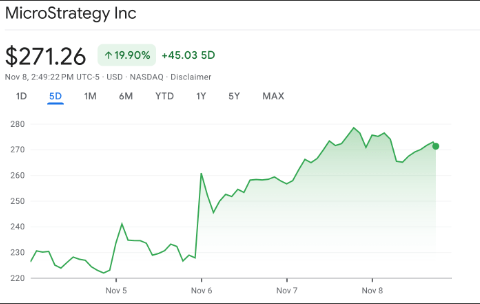MSTR has increased its Bitcoin holdings by more than 486% in the last 12 months, and by 2027, it intends to buy another $42 billion worth of Bitcoin.
Following Donald Trump’s victory in the presidential election and another round of interest rate cuts, which sent tech companies like MicroStrategy (MSRT) to a 52-week high, the stock market is poised to end the week with one of its best performances of the year.
As of this writing, MSTR shares are up about 20% over the last five days, trading at $271.26 on the Nasdaq. Due in large part to its Bitcoin (BTC) reserves strategy, the corporate analytics and mobility software company has experienced a 486% increase in share price over the last 12 months.

Founded by proponent of Bitcoin Michael Saylor, the corporation now owns more than 250,000 Bitcoin, which is valued at over $19 billion at current rates. Recently, MicroStrategy revealed that it intends to purchase $42 billion worth of Bitcoin by 2027.
Following Trump’s election, the price of cryptocurrencies surged over 10% to hit an all-time high of almost $76,600 on November 8.
The week was also good for other stocks that are associated with Bitcoin. Crypto exchange Coinbase (COIN), one of the largest funders to the US election, had its stock surge by more than 48% over the week, while shares of Bitcoin mining startup CleanSpark (CLSK) increased 35%.
Expectations of a more favorable economic climate following Trump’s reelection and more easing by the Federal Reserve are fueling investor confidence. For the first time in more over four years, the Fed lowered interest rates by 0.5 percentage points in September 2024. The federal funds rate was lowered by another 0.25 points on November 7, lowering it to 4.5% to 4.75%.
In reaction, the whole market has risen, with the Dow Jones rising 4.8% and the S&P 500 up 5% for the week, reflecting rising investor confidence.
Spot Ethereum ETF demand on the rise again, will ETH hit $4,000 soon?
Location Ethereum ETF inflows have increased significantly, reaching $155 million this week as the price of ETH soars beyond $3000 with an 18% gain.
Following Donald Trump’s victory and this week’s news of a 25 basis point Fed rate drop, inflows into the spot Ethereum ETF have resumed their upward trajectory. The overall outflow has decreased to $324 million from its peak of $550 million a few weeks ago as a result of net inflows into the Ether ETFs during the previous three days.
Spot Ethereum ETFs see renewed interest
Ethereum (ETH), the biggest cryptocurrency in the world, is also gaining significant traction in addition to Bitcoin, which has reached all-time highs above $77,000. The spot Ethereum ETF inflows have therefore increased slightly once again, reaching a weekly high of $85.9 million on Friday, November 8. With successive inflows after Donald Trump’s election, the weekly inflows therefore increased to $155 million.
The largest inflows yesterday were $59.8 million into the BlackRock Ethereum ETF (ETHA), followed by $18.4 million into Fidelity’s FETH. This week, FETH has had steady and robust inflows in addition to ETHA. According to data from Farside Investors, the most recent event marks the milestone of $1.4 billion in cumulative inflows into the BlackRock Ether ETF.
The influx that spot Bitcoin ETFs are now seeing in the US, however, still dwarfs this. However, this is a positive trend because the altseason pick-up may lead to even higher inflows.
Investors are also keeping a careful eye on changes in the price of Ethereum (ETH). With gains of 18% over the past week, ETH has surpassed BTC, which has gained 9.9%. The ETH/BTC pair, which has been declining for the last three years, is also seeing a solid rise.
Another development is that the U.S. Securities and Exchange Commission (SEC) has postponed making a judgment regarding spot Ethereum ETF options trading.
ETH price to rally to $4,000?
Investors are hopeful that if the inflows into spot Ethereum ETFs improve, the price of ETH will rise in the future. The price of Ethereum is up 4.86% as of this writing, breaking over the crucial $3,000 barrier level. The 200-day moving average (DMA) is flipped by ETH, changing the attitude from pessimistic to optimistic, making this a pivotal breakout.
A further rise to $4,000 may result if the bulls are able to maintain current levels with assurance. Additionally, a 90-day accumulation with a strong upward trend precedes this Ethereum breakthrough. According to some observers, this may be the start of the massive bull run to $15,000.
The only ETH chart you need to see right now pic.twitter.com/qNblQZInm1
— Yoddha (@CryptoYoddha) November 8, 2024
AI News: Lilian Weng exits OpenAI adding to a list of safety team departures
AI News: Lilian Weng, VP of Research and Safety at OpenAI, resigns, bringing attention to patterns in AI safety departures as priorities change.
AI news: After seven years at OpenAI, Lilian Weng, VP of Research and Safety, has declared her intention to depart the firm. Weng was instrumental in the creation of OpenAI’s safety measures, which are a vital feature of the business’s responsible AI approach.
Her resignation, which takes effect on November 15, comes after a recent exodus of OpenAI’s AI safety staff, which also included Ilya Sutskever and Jan Leike. In order to manage superintelligent AI, the two co-led the Superalignment team.
AI News: OpenAI’s safety VP Lilian Weng resigns, citing a need for new challenges
Lilian Weng, who joined OpenAI in 2018, gave an explanation of her decision to leave the firm in a post on X, previously Twitter. Weng said she believed it was time to “reset and explore something new” after seven years. She played a key part in the creation of the Safety Systems team at OpenAI, which grew to comprise more than 80 people.
Furthermore, Weng acknowledged the team’s accomplishments, expressing delight in its advancement and her belief that it would flourish even after she left. Weng’s departure, however, reflects a recurring pattern among OpenAI’s AI safety team members, several of whom have expressed dissatisfaction with the organization’s changing goals.
As a member of OpenAI’s robotics team, Weng first worked on challenging projects like teaching a robotic hand to solve a Rubik’s cube. She moved into artificial intelligence safety positions over time, and once GPT-4 was released, she finally became charge of the startup’s safety programs. She became more focused on making sure OpenAI’s AI models were developed safely as a result of this shift.
Weng did not outline her goals in the most current AI news, but she said,
“After working at OpenAI for almost 7 years, I decide to leave. I learned so much and now I’m ready for a reset and something new.”
OpenAI disbands Superalignment team as safety priorities shift
The Superalignment project, which was managed by Jan Leike and co-founder Ilya Sutskever and aimed to provide safeguards against potentially superintelligent AI, was recently disbanded by OpenAI. This team’s disbandment has raised questions about OpenAI’s preference for commercial goods above security.
Recent AI news claims that OpenAI leadership, including CEO Sam Altman, prioritized the release of powerful generative models like GPT-4o above funding superalignment research. According to reports, this concentration caused Leike and Sutskever to depart early this year, followed by other OpenAI employees working in the AI safety and policy divisions.
Ilya and OpenAI are going to part ways. This is very sad to me; Ilya is easily one of the greatest minds of our generation, a guiding light of our field, and a dear friend. His brilliance and vision are well known; his warmth and compassion are less well known but no less…
— Sam Altman (@sama) May 14, 2024
The goal of the Superalignment team was to develop management strategies for AI systems that might do activities on par with humans in the future. However, its disassembly has heightened worries among industry experts and former workers who argue that the company’s focus on product development may come at the expense of strong safety protocols.
OpenAI has unveiled ChatGPT Search, which uses the sophisticated GPT-4o model to provide real-time search capabilities for a range of information, including news updates, sports, and financial markets.
Elon Musk, the CEO of Tesla, has also expressed worries about the dangers of AI, predicting that there is a 10–20% possibility that these advancements would go awry. During a recent conference, Musk urged greater attention to detail and ethical issues in the development of AI. He underlined that over the next two years, AI’s quick development may allow computers to execute intricate jobs on par with human capabilities.


